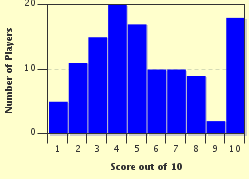Quiz Answer Key and Fun Facts
1. The peregrine falcon came very close to extinction at the end of the 20th century due to widespread use of a chemical pesticide now banned in most developed countries. What is the name of that pesticide, which causes the eggshells of raptors to become thin and brittle?
2. Turning out the lights of highrise buildings at night does more than save energy. What other benefit does it have?
3. The first bird found only in North America that is known to have become extinct was a seabird that once inhabited the area around the mouth of the St. Lawrence river. What was it called?
4. What ongoing practice is a threat to pretty migratory species like the painted bunting, Scott's orioles and cedar waxwings?
5. Although backyard feeders can help support local birds, there are some problems associated with throwing food to wild migratory shorebirds. Which of the following is NOT considered to be a damaging effect of "feeding the ducks"?
6. In the late 20th and early 21st century, honeybee populations in North America, Europe and Asia have been very badly affected by a parasite that can contribute to the death of as much as 25% of a hive over a cold winter. What is this pest?
7. Cultivating soil (turning it over or tilling it) can be harmful to beneficial insect pollinators. Why?
8. Which of the following gardening practices is best for helping to protect wild insect pollinators like bees?
9. Which of the following types of plants is NOT especially helpful to foraging bees?
10. One of the following types of chemical pesticides, currently used in corn and soy farming, has been found to be extremely toxic to bees. Which one?
Source: Author
SBH
This quiz was reviewed by FunTrivia editor
Tizzabelle before going online.
Any errors found in FunTrivia content are routinely corrected through our feedback system.

